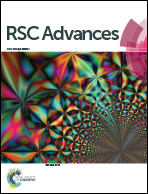A microwave-activated coal fly ash catalyst for the oxidative elimination of organic pollutants in a Fenton-like process†
Abstract
Raw coal fly ash was first activated by microwave irradiation to promote its catalytic potential and then used as a Fenton-like catalyst to treat polyacrylamide-contaminated wastewater. The optimal activation conditions of the raw coal fly ash (microwave power = 700 W, irradiation time = 10 min, mixing speed = 120 rpm, and raw coal fly ash loading = 20 g L−1) were determined by the orthogonal test. The significance of each effective parameter follows the order: raw coal fly ash loading > microwave power > irradiation time > mixing speed. Microwave irradiation can change the surface morphology and remarkably increase the specific surface area and pore volume. More than 75% of the TOC in the polyacrylamide-contaminated wastewater can be removed under the optimized treatment conditions ([H2O2] = 12 mg L−1, catalyst loading = 10 g L−1, [polyacrylamide] = 200 mg L−1, T = 313 K). The kinetic study shows that the variation in the catalyst loading and the polyacrylamide concentration can change the degradation path of the polyacrylamide, whereas the variation in the H2O2 dosage can accelerate the degradation of polyacrylamide. The Fenton-like process studied herein has a wider optimal pH range (2–5) than that of the classic Fenton process (3). The catalyst has weak catalytic capacity but better catalytic persistence than that of Fe2+. During the five runs of the catalyst, some heavy metallic and toxic elements (Fe, Al, Ti, Cr, Mn, etc.) can be detected but under the limits of the GB8978-1996 standard. Leaching can weaken the catalytic capacity (i.e., stability) of the catalyst. The catalytic process is caused by the synergism of multiple metals and consists of heterogeneous and homogeneous processes.



 Please wait while we load your content...
Please wait while we load your content...